Vapor Lock???
you can't generally cure a problem until you test to find out the cause,of the symptoms.
at this point your simply assuming its "vapor lock" or a heat related issue, you don,t mention your fuel pressure, your fuel pump capacity, having accurately measured the fuel pump flow.
all fuel pumps PUSH fuel far more efficiently than they SUCK fuel and sitting in traffic may allow heat to turn the liquid fuel in the lines supplying the fuel pump to vapor, thus the lag in fuel delivery once you start moving as it takes time for the liquid fuel flow too return through the manual fuel pump, as the fuel in the feed lines easily vaporized as its not under pressure.
the pressurized fuel between the fuel pump and carb is less likely to vaporize with engine heat, but the fuel line supplying UN-pressurized fuel to the fuel pump likely has ethanol laced gas, that boils at about 175F so if the fuel line is subjected to heat from the exhaust that's not being constantly whisk away due to rapid constant cooler air flow in a moving car like would happen in bumper to bumper traffic it may (probably will cause problems) insulating the feed line should help
you didn't say if you've used a heat insulating barrier spacer to try to reduce the carbs temperature or a dozen other tests , like measuring the float levels and fuel pressure at the carb inlet port,you could do to confirm the issues cause.
adding a high quality return style fuel pressure regulator and a return line would surely help, as it would result in a constant supply of cooler fuel reaching the carb.
IF its a heat related fuel delivery issue, the fast and reasonably priced fix is adding a second, low pressure, electric fuel pump and high flow low restriction fuel filter near the fuel tank to pressure feed the existing manual fuel pump,or eliminating the manual fuel pump completely and replace it with either an in the fuel tank electric or externally mounted, electric fuel pump in or mounted externally near the fuel tank.
youll ideally want a 120-160 gph electric fuel pump that has AN#8 or 1/2" line fittings and it certainly would help to install a return style fuel pressure regulator and return line to the fuel delivery system.
keep in mind the rated fuel flow is generally taken with little or no resistance to flow that the pump will see under real world conditions so your lucky to get 1/2-to-2/3rds of the rated flow volume, once the lines fittings and fuel filters connected.
while the heat reflective foil on the fuel line between the fuel pump and the carb may have helped a bit its the fuel line between the tank and fuel pump (the fuel pump feed) thats far more likely too be the cause of the problem, pressurized liquid fuels far less likely to be effected by heat than the fuel subjected to low pressure suction feeding the fuel pump.
btw they make effective slip on thermal insulation.
https://www.summitracing.com/parts/...eld-products&gclid=CJbHgM_1qM8CFQwQgQodmTEHHQ
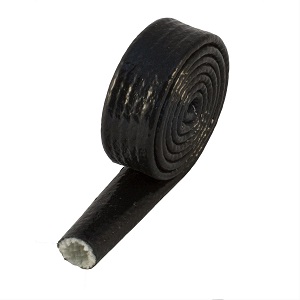
the simplest way to control or avoid vapor lock conditions, is a two step approach, first you want to have a constantly replaced, fuel flow volume, this is easily accomplished if you select a fuel pump that supplies fuel at about 7 psi-12 psi and has a rated flow of at least 100 gallons per hour (most of the better quality performance fuel pumps will do this,)
but having a bye-pass fuel pressure regulator connected after the carb inlet port, the pump will thus force room temp, liquid fuel up the fuel lines and into the carb inlet, and past the carb inlet port too the fuel pressure regulator , where a spring in the fuel pressure regulator opens any time fuel pressure exceeds an adjustable back pressure you set at about 4.5 psi-5 psi, thus its constantly flushing a significant volume of the fuel past the carb inlet port and back too the fuel tank through the return line, this mandates the fuel does not have time to absorb much heat and its under constant pressure so theres zero chance for fuel vapor to build up displacing liquid fuel delivered to the fuel bowls.
fuel return lines to the fuel tank should have near zero flow restriction, generally they are the same internal or even larger in internal cross sectional area to the pressurized fuel feed lines to insure this easy low restriction flow.
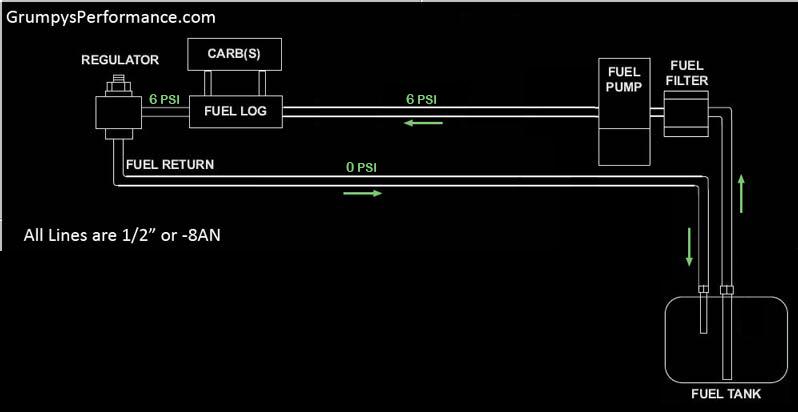
they make effective slip on thermal insulation.
that can be slipped over fuel lines to reduce the potential for heat absorption in the engine compartment.
https://www.summitracing.com/parts/...eld-products...
phenolic spacers work well just don,t get the cheap plastic knock off versions that warp and leak, and be aware that the dual plane intakes tend to work best with the 1"and 2" four hole designs but single planes tend to work best with the larger single open plenum designs
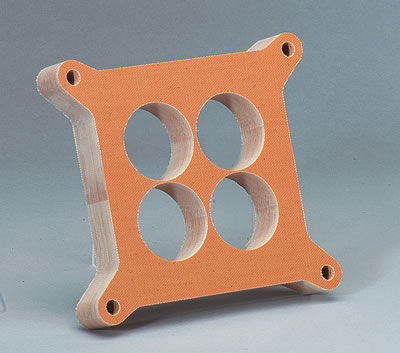
http://www.summitracing.com/parts/SUM-G1404/
http://garage.grumpysperformance.co...//garage.grumpysperformance.com/index.php?thr..
you must also restrict heat build-up potential in the carb fuel bowls, this is generally done with a very poor thermal conductive spacer between the carb base and the intake manifold.
the problem with all decent quality fuel line supply component parts is they cost more money, than the cheap low quality parts and generally take up more room and take a bit more time and thought to instal correctly
http://www.summitracing.com/parts/hly-12-841/overview/
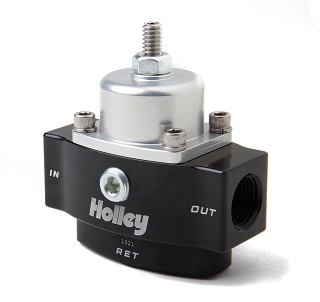
http://www.amazon.com/Moeller-Separatin ... d_sbs_sg_1
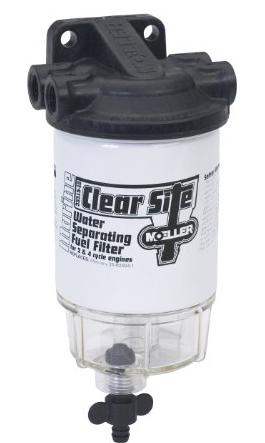
almost every car on the road today runs a return line,
and fuel pressure regulator equipped fuel system,
If your running an old school muscle car with a manual fuel pump, your manual fuel pump cycles once every revolution,as the fuel pump cam lobe on the cam pumps the fuel pump,it works less hard if its flowing fuel rather than pumping against a peak pressure.
having a fuel pressure return line allowing excess fuel volume through the fuel pressure regulator, too return to the tank helps avoid heating fuel
http://pure-gas.org/extensions/map.html
https://gasnearmestation.com/non-ethanol-gas-near-me/
E85 gas station locations
http://e85locator.net/E85locations.html
read this
http://garage.grumpysperformance.co...ts-inside-a-manual-fuel-pump.5365/#post-16067


carb equiped fuel delivery also benefits

in fact most cars have the fuel pumps today are located in the fuel tank and sloshing fuel cools and lubes the pump, the fact the fuel flows with minimal resistance compared to a dead head system allows the pump to work under less stress.
yes fuel pumps do wear out.. everything mechanical does eventually, but Ive generally seen 8-12 years out of most fuel pumps
youll benefit from a fuel delivery system and fuel pressure regulator that has a return line that routes excess fuel flow back to the tank, fuel pumps with internal bye-pass regulators generally are not nearly ass effective
READ THESE LINKS CAREFULLY
http://garage.grumpysperformance.com/index.php?threads/setting-up-your-fuel-system.211/
http://garage.grumpysperformance.com/index.php?threads/how-big-a-fuel-pump-do-you-need.1939/
http://garage.grumpysperformance.com/index.php?threads/fuel-pressure-regulators.635/
[URL='http://www.digitalcorvettes.com/forums/member.php?u=118014']SlyVette[/URL] said:I have a 69' sb with AC and a new Dewitt's aluminum rad that I installed to keep me cool in this Florida heat and all is good.
The problem I have and have had since before the AC install is....
I can drive the car all day without a problem until I get stopped in traffic.
When I accelerate after being stopped I get a stumble after a few hundred feet. It never has stalled out completely and if I depress the clutch and rev it up it clears out and runs well until the next time I get stopped.
I have a Q-Jet carb with a 3/8" hard line from the OE mechanical pump and a vented tank. The paper filter in the carb is fresh and I also have an in line filter on the passenger side frame rail and it to has been changed.
I currently have no provisions at the engine for a return line although I do have a nipple at the tank that is currently capped.
I have the hard line wrapped with insulation and aluminum foil and besides looking like crap it hasn't helped a bit!
Any recommendations on how to remedy this?
I am not looking forward to installing a return line parallel to the supply line. My days of lifting the body off of the frame have passed.
If that is the only answer I'll have to do it but I'm hoping there is another solution.
you can't generally cure a problem until you test to find out the cause,of the symptoms.
at this point your simply assuming its "vapor lock" or a heat related issue, you don,t mention your fuel pressure, your fuel pump capacity, having accurately measured the fuel pump flow.
all fuel pumps PUSH fuel far more efficiently than they SUCK fuel and sitting in traffic may allow heat to turn the liquid fuel in the lines supplying the fuel pump to vapor, thus the lag in fuel delivery once you start moving as it takes time for the liquid fuel flow too return through the manual fuel pump, as the fuel in the feed lines easily vaporized as its not under pressure.
the pressurized fuel between the fuel pump and carb is less likely to vaporize with engine heat, but the fuel line supplying UN-pressurized fuel to the fuel pump likely has ethanol laced gas, that boils at about 175F so if the fuel line is subjected to heat from the exhaust that's not being constantly whisk away due to rapid constant cooler air flow in a moving car like would happen in bumper to bumper traffic it may (probably will cause problems) insulating the feed line should help
you didn't say if you've used a heat insulating barrier spacer to try to reduce the carbs temperature or a dozen other tests , like measuring the float levels and fuel pressure at the carb inlet port,you could do to confirm the issues cause.
adding a high quality return style fuel pressure regulator and a return line would surely help, as it would result in a constant supply of cooler fuel reaching the carb.
IF its a heat related fuel delivery issue, the fast and reasonably priced fix is adding a second, low pressure, electric fuel pump and high flow low restriction fuel filter near the fuel tank to pressure feed the existing manual fuel pump,or eliminating the manual fuel pump completely and replace it with either an in the fuel tank electric or externally mounted, electric fuel pump in or mounted externally near the fuel tank.
youll ideally want a 120-160 gph electric fuel pump that has AN#8 or 1/2" line fittings and it certainly would help to install a return style fuel pressure regulator and return line to the fuel delivery system.
keep in mind the rated fuel flow is generally taken with little or no resistance to flow that the pump will see under real world conditions so your lucky to get 1/2-to-2/3rds of the rated flow volume, once the lines fittings and fuel filters connected.
while the heat reflective foil on the fuel line between the fuel pump and the carb may have helped a bit its the fuel line between the tank and fuel pump (the fuel pump feed) thats far more likely too be the cause of the problem, pressurized liquid fuels far less likely to be effected by heat than the fuel subjected to low pressure suction feeding the fuel pump.
btw they make effective slip on thermal insulation.
https://www.summitracing.com/parts/...eld-products&gclid=CJbHgM_1qM8CFQwQgQodmTEHHQ

the simplest way to control or avoid vapor lock conditions, is a two step approach, first you want to have a constantly replaced, fuel flow volume, this is easily accomplished if you select a fuel pump that supplies fuel at about 7 psi-12 psi and has a rated flow of at least 100 gallons per hour (most of the better quality performance fuel pumps will do this,)
but having a bye-pass fuel pressure regulator connected after the carb inlet port, the pump will thus force room temp, liquid fuel up the fuel lines and into the carb inlet, and past the carb inlet port too the fuel pressure regulator , where a spring in the fuel pressure regulator opens any time fuel pressure exceeds an adjustable back pressure you set at about 4.5 psi-5 psi, thus its constantly flushing a significant volume of the fuel past the carb inlet port and back too the fuel tank through the return line, this mandates the fuel does not have time to absorb much heat and its under constant pressure so theres zero chance for fuel vapor to build up displacing liquid fuel delivered to the fuel bowls.
fuel return lines to the fuel tank should have near zero flow restriction, generally they are the same internal or even larger in internal cross sectional area to the pressurized fuel feed lines to insure this easy low restriction flow.

they make effective slip on thermal insulation.
that can be slipped over fuel lines to reduce the potential for heat absorption in the engine compartment.
https://www.summitracing.com/parts/...eld-products...
phenolic spacers work well just don,t get the cheap plastic knock off versions that warp and leak, and be aware that the dual plane intakes tend to work best with the 1"and 2" four hole designs but single planes tend to work best with the larger single open plenum designs

http://www.summitracing.com/parts/SUM-G1404/
http://garage.grumpysperformance.co...//garage.grumpysperformance.com/index.php?thr..
you must also restrict heat build-up potential in the carb fuel bowls, this is generally done with a very poor thermal conductive spacer between the carb base and the intake manifold.
the problem with all decent quality fuel line supply component parts is they cost more money, than the cheap low quality parts and generally take up more room and take a bit more time and thought to instal correctly
http://www.summitracing.com/parts/hly-12-841/overview/

http://www.amazon.com/Moeller-Separatin ... d_sbs_sg_1

almost every car on the road today runs a return line,
and fuel pressure regulator equipped fuel system,
If your running an old school muscle car with a manual fuel pump, your manual fuel pump cycles once every revolution,as the fuel pump cam lobe on the cam pumps the fuel pump,it works less hard if its flowing fuel rather than pumping against a peak pressure.
having a fuel pressure return line allowing excess fuel volume through the fuel pressure regulator, too return to the tank helps avoid heating fuel
http://pure-gas.org/extensions/map.html
https://gasnearmestation.com/non-ethanol-gas-near-me/
E85 gas station locations
http://e85locator.net/E85locations.html
read this
http://garage.grumpysperformance.co...ts-inside-a-manual-fuel-pump.5365/#post-16067


carb equiped fuel delivery also benefits

in fact most cars have the fuel pumps today are located in the fuel tank and sloshing fuel cools and lubes the pump, the fact the fuel flows with minimal resistance compared to a dead head system allows the pump to work under less stress.
yes fuel pumps do wear out.. everything mechanical does eventually, but Ive generally seen 8-12 years out of most fuel pumps
youll benefit from a fuel delivery system and fuel pressure regulator that has a return line that routes excess fuel flow back to the tank, fuel pumps with internal bye-pass regulators generally are not nearly ass effective
READ THESE LINKS CAREFULLY
http://garage.grumpysperformance.com/index.php?threads/setting-up-your-fuel-system.211/
http://garage.grumpysperformance.com/index.php?threads/how-big-a-fuel-pump-do-you-need.1939/
http://garage.grumpysperformance.com/index.php?threads/fuel-pressure-regulators.635/
Last edited:
